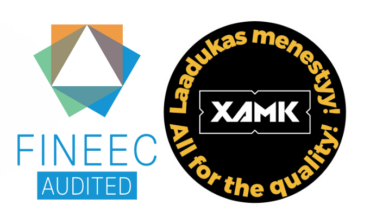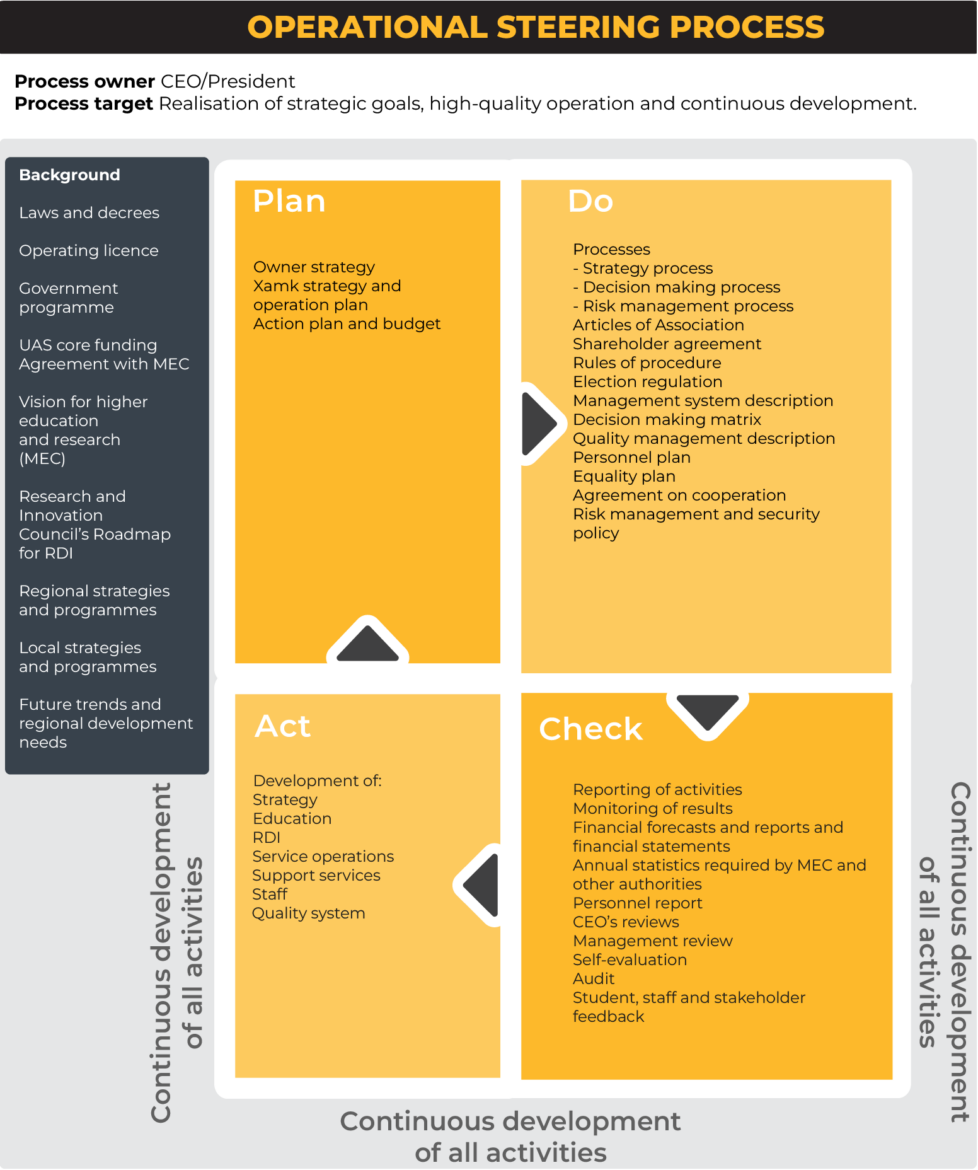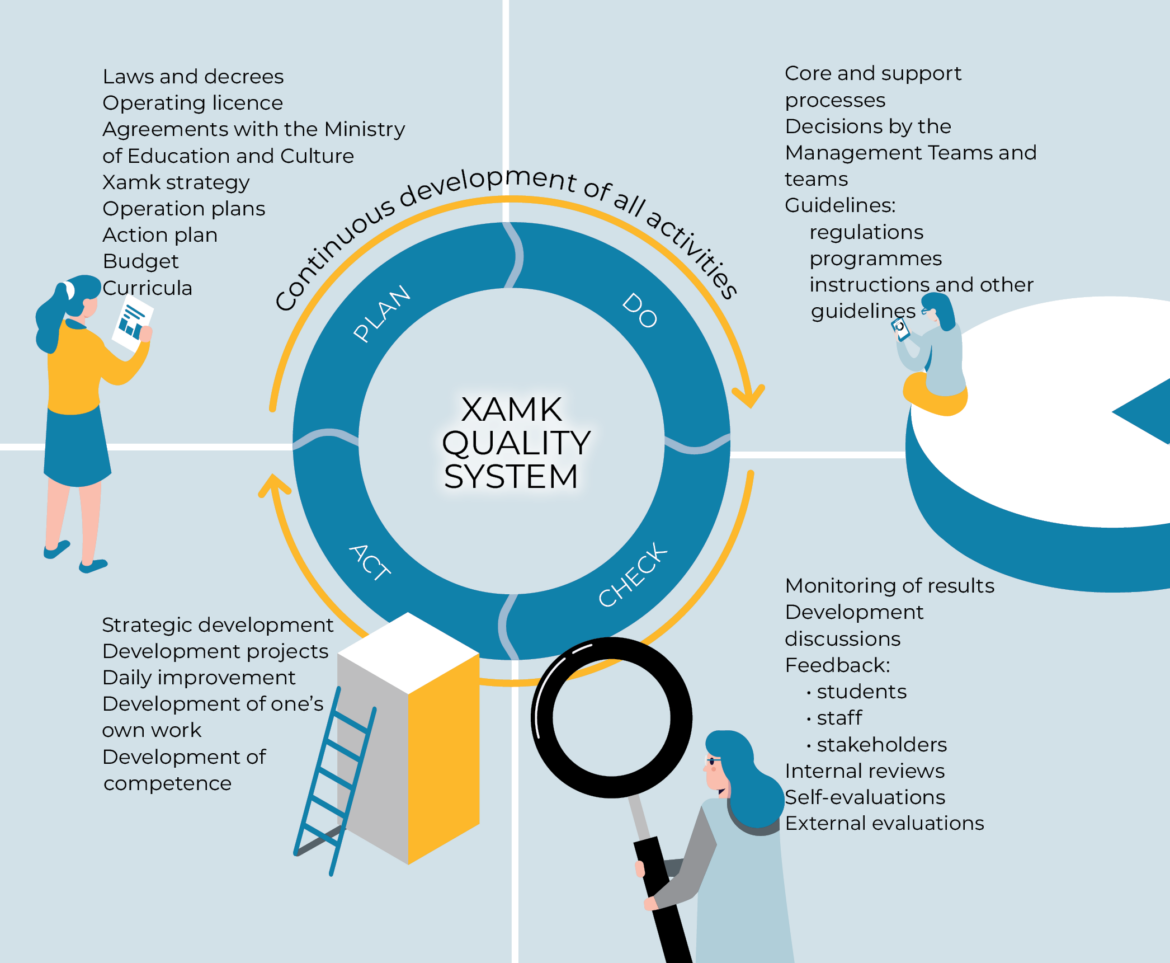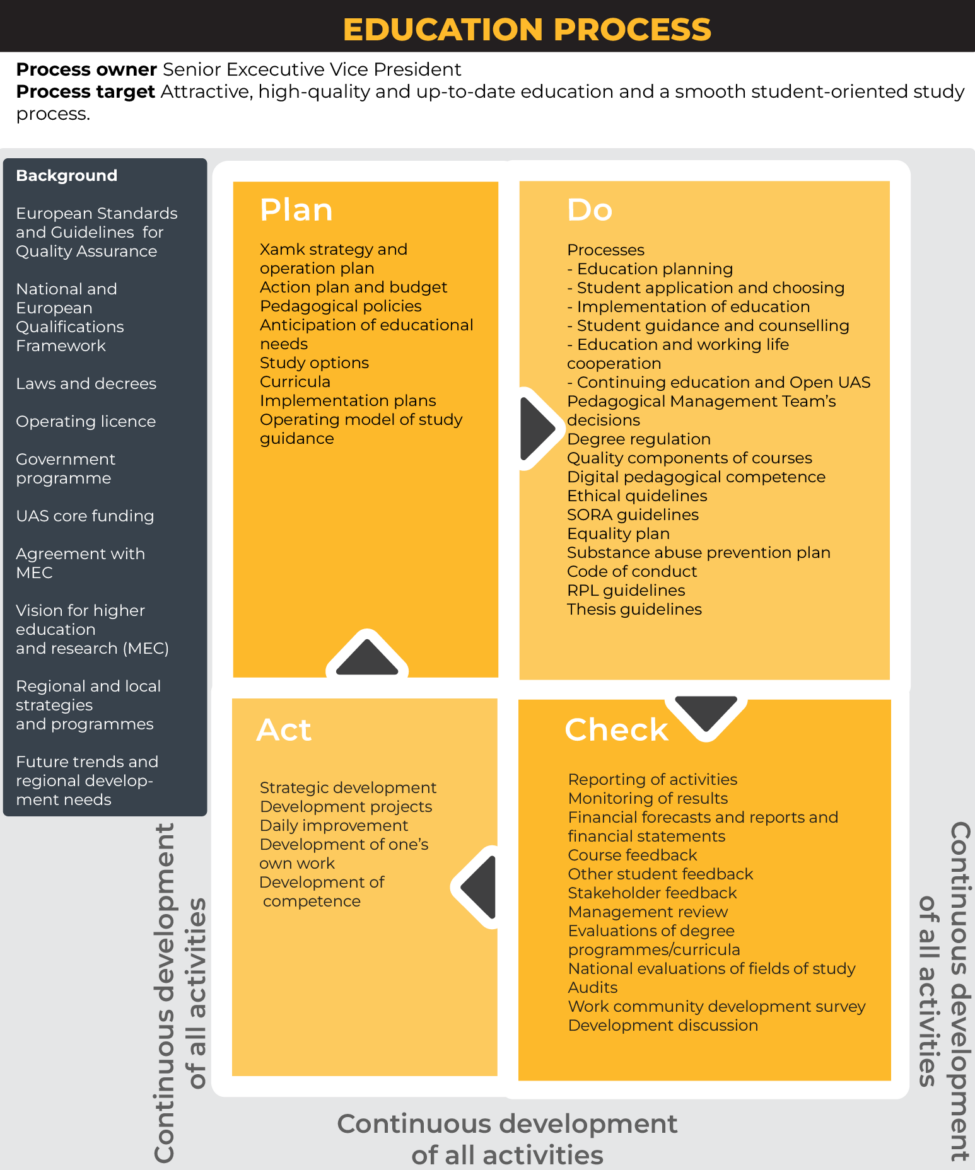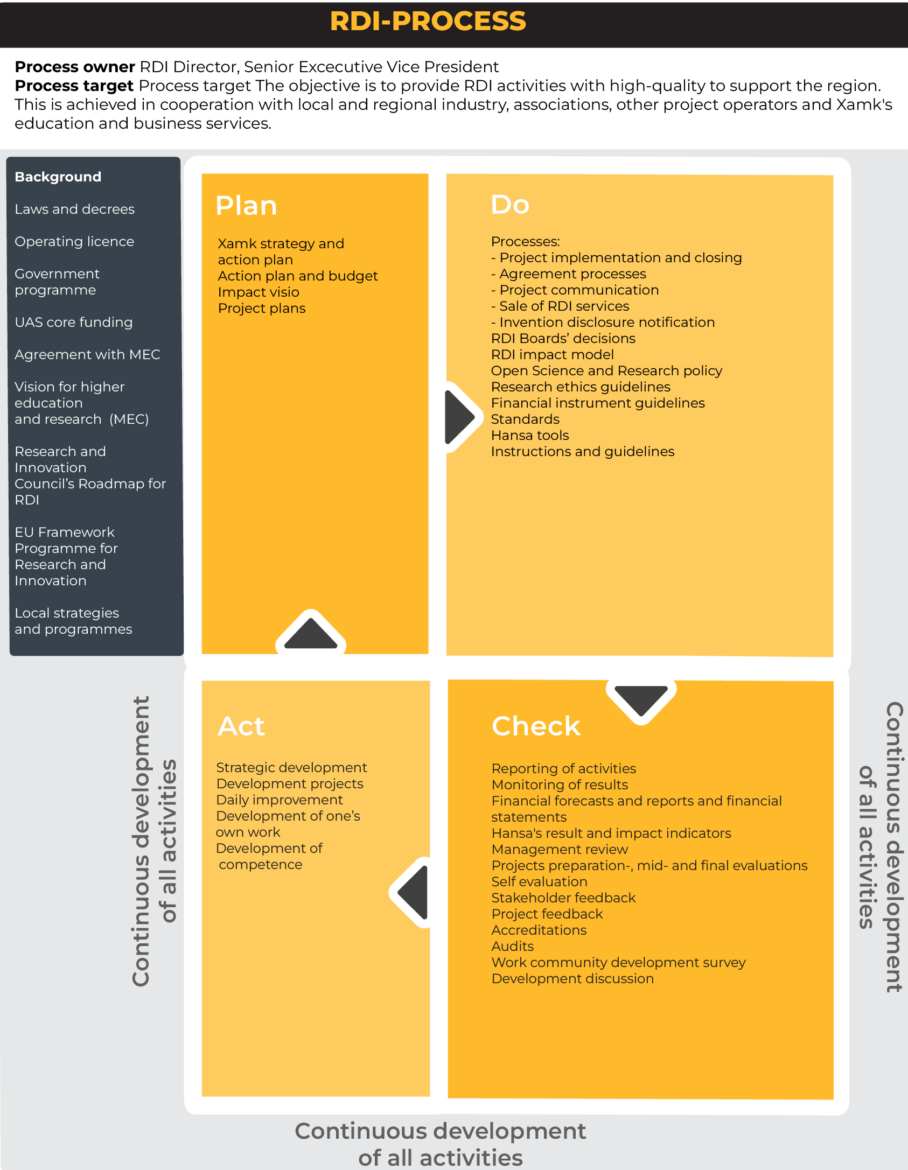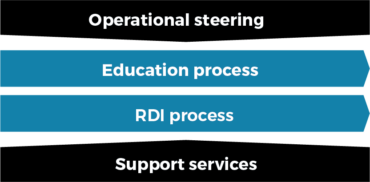
Quality Management Description
Quality assessment and development involves improving activities and maintaining strengths: following targets and requirements, developing competence, meeting customer and stakeholder needs and streamlining processes.
All for the Quality!
Student, staff and stakeholder participation and making use of feedback and ideas play an important role in development work. All Xamk community members share the responsibility for the quality of operations and its development. Conditions for quality operations are established by creating an active and open atmosphere.
Xamk’s common quality system includes our common quality policy, responsibilities and the methods and tools of continuous development that provide the framework for our operations and for maintaining and developing them and their quality. Xamk quality systems follows the recommendations of the European Standards and Guidelines for Quality Assurance in Higher Education (ESG). This is ensured through the audit by the Finnish Education Evaluation Centre (FINEEC).
This quality management description outlines Xamk’s quality management and serves as a quality manual. This description is complemented by Xamk’s process descriptions in the IMS management solutions software and the instructions and guidelines available through the intranets for staff and/or students.
1. Why does Xamk assess and develop quality?
Finnish higher education institutions (HEIs) are under the Finnish Universities of Applied Sciences Act (932/2014) responsible for the quality and continuous development of their education and other operations. The legislation involves the assessment of education, other operations and their impact. HEIs are also required to undergo regular external evaluations of their operations and quality systems and to publish the results of such evaluations.
Based on Xamk strategy we are all for the future and continuously renew our operations. Quality assessment, continuous improvement and maintenance of strengths are part of this work. Our quality system systematically produces information to support the management and operational steering, and the information is used in all Xamk operations. We aim at an atmosphere of development and operational culture where activities are improved and new ideas adopted. The quality system ensures the participation of students, staff and stakeholders in the development of activities. High-quality operations ensure Xamk’s societal impact and provide competitive edge.
European Standards and Guidelines (ESG)
Xamk’s common quality system includes quality policy, responsibilities and common methods and tools of continuous development as a framework for operations and for maintaining and developing activities and their quality. Xamk quality system follows the recommendations of the Standards and Guidelines for Quality Assurance in the European Higher Education (ESG) that use the term quality assurance. Finnish HEIs, in turn, prefer referring to quality management, assessment, and development.
ESG sets two aims for the quality assurance activites of HEIs: accountability and enhancement. These create trust in the performance and results of HEIs. A successfully implemented quality assurance system provides information to assure the HEI and the public of the quality of the HEI’s operations (accountability) as well as to provide advice and recommendations on how it can improve what it is doing (enhancement). Quality assurance and quality enhancement are thus interrelated. They can support the development of a quality culture that is adopted by all: from the students and academic staff to the institutional leadership and management
ESG has ten standards and guidelines for internal quality assurance that are listed and described below. They focus on the quality assurance of education. Xamk’s quality management, however, also covers all its responsibilities, including the research, development and innovation (RDI) activities that promote the working life, regional development and renewal of regional economic structures as well as lifelong and continuous learning.
1. POLICY FOR QUALITY ASSURANCE
HEIs should have a policy for
quality assurance that is made public and forms part of their strategic management. Internal stakeholders should develop and implement this policy through appropriate structures and processes, while involving external stakeholders.
2. DESIGN AND APPROVAL OF (DEGREE) PROGRAMMES
HEIs should have processes for the design and approval of their programmes. The programmes should be designed to meet the objectives set for them, including the intended learning outcomes. The qualification resulting from a programme should be clearly specified and communicated, and refer to the correct level of the national qualifications framework for higher education and, consequently, to the Framework for Qualifications of the European Higher Education Area.
3. STUDENT-CENTRED LEARNING, TEACHING AND ASSESSMENT
HEIs should ensure that the programmes are implemented in a way that encourages students to take an active role in creating the learning process, and that the assessment of students reflects this approach.
4. STUDENT ADMISSION, PROGRESS OF STUDIES, RECOGNITION AND CERTIFICATION
HEIs should consistently apply pre-defined and published regulations covering all phases of the student “life cycle”, including, for example, student admission, the progress of studies, recognition of previous studies and certification.
5. TEACHING STAFF
HEIs should assure themselves of the competence of their teachers. They should apply fair and transparent processes for staff recruitment and development.
6. LEARNING RESOURCES AND STUDENT SUPPORT
HEIs should have appropriate funding for learning and teaching activities and ensure that adequate and readily accessible learning resources and support for students are provided.
7. INFORMATION MANAGEMENT
HEIs should ensure that they collect, analyse and use relevant information for the effective management of their programmes and other activities.
8. PUBLIC INFORMATION
HEIs should publish information about their activities, including programmes, which is clear, accurate, objective, up-to-date and readily accessible.
9. ON-GOING MONITORING AND PERIODIC REVIEW OF (DEGREE) PROGRAMMES
HEIs should monitor and periodically review their programmes to ensure that they achieve the objectives set for them and respond to the needs of students and society. These reviews should lead to continuous improvement of the programmes. Any action planned or taken as a result should be communicated to all those concerned.
10. CYCLICAL EXTERNAL QUALITY ASSURANCE
HEIs should undergo external quality assurance in line with the ESG on a cyclical basis.
AUDIT OF THE QUALITY SYSTEM
An audit refers to independent and systematic external evaluation. It assesses whether the quality system of Xamk is fit for purpose and functioning, and whether it complies with the agreed criteria. The evaluation targets the methods and tools to maintain and develop the quality of operations.
Finnish HEIs are audited by the Finnish Education Evaluation Centre (FINEEC) at six-year intervals. The audit targets the entire quality system of a HEI and involves all operations. FINEEC publishes the evaluation criteria in its audit manual. FINEEC audits are arranged to
- evaluate, if the HEI quality systems meet the European quality assurance standards,
- assess, if the quality systems produce relevant information for the continuous development of operations and whether it results in effective development activities,
- encourage international activities, experimenting and a creative atmosphere at HEIs and
- accumulate open and transparent information on quality work at Finnish HEIs.
The audit is implemented in accordance with the principle of enhancement-led evaluation. The audit highlights learning, recognising strengths and development targets during the process as well as the feedback for development received.
FINEEC’S Higher Education Evaluation Committee decides on the result of the audit. After passing the audit, Xamk will receive a certificate, an electronic quality label and will be entered in the register of audited HEIs maintained by FINEEC on its website. The quality label is valid for six years. If the HEI does not pass the audit, it is allowed a re-audit.
QUALITY MANAGEMENT IN SUPPORT OF STRATEGIC MANAGEMENT
Xamk’s quality system is part of its strategic planning, management and operational steering. Operational steering ensures that the strategy, targets and plans result in concrete activities at different organisational levels and in related follow-up and evaluation. Xamk quality system supports the development of activities and competence and ensures that the information received through feedback and assessment is used to set directions for improvement. Xamk’s operational steering process is described on the figure..
CONTINUOUS DEVELOPMENT IN EVERYDAY WORK
All Xamk community members make efforts towards quality in our activities and in providing high-quality services for our students, customers and stakeholders. All Xamk community members’ active and development-oriented role in their own and in the work community’s duties is important. This is enabled by an atmosphere of open discussion and with possibilities to influence one’s own work and to participate in common planning and development of activities.
In assessing one’s own work and in making small improvements all Xamk community members can benefit from the information produced by Xamk quality system, such as course feedback, project assessment results or valuable daily observation as well as immediate feedback from students or other customers. Development ideas, their prompt testing and assessment of their functionality are important in terms of dynamic, agile and flexible operations.
QUALITY POLICY
Xamk’s quality management and its principles are described in our quality policy that is implemented through the quality system in the following way:
- Xamk values quality. The strategic management and operational steering base on the information systematically produced by the quality system.
- High-quality operations ensure Xamk’s societal impact that play an important role in its competitivity.
- Quality targets, their maintenance and improvement base on Xamk strategy and integrate into Xamk’s and its different units’ operations.
- Quality assessment and development tools selected involve efficient and economical methods and operation models that motivate students and staff in improving quality.
- Quality work follows the principles of transparency, reliability and confidentiality.
- The quality system and the data produced are documented on the staff and student intranets and on the Xamk website according to the user group needs.
- Communication on the information produced by the quality system is active.
2. Who create quality at Xamk?
Xamk students and staff as a community are committed to quality work. All Xamk community members are responsible for the quality and development of their own activities and actively participate in common development. In addition, stakeholder representatives are involved in assessing and developing operations. This atmosphere of collective development provides foundations to our quality culture. Xamk’s quality culture means an atmosphere of long-term development of operations where strengths and development targets are identified actively and with determination. The results are used to launch development actions at different organisation levels with the aim of continuously improving the operations, as well as maintaining and making the best of our strengths.
Xamk’s quality culture means an atmosphere of long-term development of operations where strengths and development targets are identified actively and with determination. The results are used to launch development actions at different organisation levels with the aim of continuously improving the operations, as well as maintaining and making the best of our strengths.
| Quality executives | Quality responsibilities |
| Students | Students are responsible for their own learning and the progress of their studies. They have the right to give constructive feedback in order to develop education and other operations. |
| Student Union Kaakko | The student body has the responsibility for student participation in Xamk’s development work by naming representatives to the Xamk Board, other bodies and to the degree programme development forums and teams/meetings. |
| Staff | All staff members are responsible for the quality and development of their own activities. They have the right to receive and give constructive feedback to support the development of operations. Staff members also ensure that they follow common processes and guidelines. |
| Directors of Education, Research Directors and unit managers | Directors and unit managers are responsible in their own unit or field for – the operational quality and results – the functionality of the quality management – the launch of the feedback surveys and the related analysis at Xamk level – the documentation related to the quality management system at Xamk level – the orientation of staff in their own area of responsibility to Xamk quality management. |
| Studies Coordinators | Studies Coordinator are responsible for orientating students with Xamk quality management and students quality responsibilities. They organize students to answer to the arrival survey and analyse the results with them as part of Study and career planning -course. |
| Degree Programme Coordinators | Degree Programme Coordinators participate in the analysis of degree programme feedback by attending development forum work. They are responsible for taking forward the development activities agreed on. |
| Quality Manager | Quality Manager has total responsibility for the implementation of Xamk’s quality policy through the quality system. Quality Team is chaired by Quality Manager. |
| Quality Team
Quality Services |
Quality Team and Quality Services are responsible for – the development of Xamk quality system – the coordination and instructions of quality management to the departments and units – the internal and, when required, external communication related to quality management – the launch of feedback surveys and analysis of the results at Xamk level – the documentation related to the quality management system at Xamk level. |
| President / CEO | President / CEO has the overall responsibility for the successful management of Xamk operations and the operational quality and results. |
| Management Team | The Management Team is responsible for the strategic steering of quality management, for launching Xamk level development activities, and for monitoring and assessing their implementation. In addition, the board members are in charge of the quality and results in their own field of responsibility. |
| Xamk Board | The Xamk Board monitors the strategy implementation and achieving the targets set for Xamk. |
| Stakeholders | The stakeholder representatives participate in different ways in developing Xamk’s education, RDI activities and business services. They also give feedback and assess operations. |
3. What does Xamk quality system consist of?
Xamk quality system consists of
- quality policy
- quality responsibilities and
- the methods and tools to continuously assess and improve our activities.
Xamk quality management bases on the principle of continuous development of the PDCA model (Plan, Do, Check, Act) where the four stages form an iterative cycle.
Xamk quality system aims are to
- systematically produce information to support the management and development
- of activities to ensure the quality of all activities.
- ensure that the information is used to support the development activities at all the levels of the organisation.
- clarify and harmonise the responsibilities of all actors concerning quality management.
- standardise the practices and to share good practices.
- support the participation of the Xamk community members – students, staff, and stakeholders – in developing the activities.
- strengthen the quality culture, ie the atmosphere of continuous development.
- maintain and strengthen transparency, reliability and confidentiality.
PLANNING STAGE
Xamk’s activities and quality management are directed by the strategy which enlists the strategic choices and targets. The strategy is made under the supervision of the Xamk Board in interaction with the management, staff, student union and stakeholders. The strategy is updated when changes in the operational environment, foresight information, assessment of development activities and the instructions of the Ministry of Education and Culture (MEC) call for it. Strategic policy definitions are included annually in the actions plans and budgets of Xamk and its departments and units. In addition to Xamk strategy, operative planning bases on operation plans that further specify the strategy. Foresight/anticipation is a crucial part of planning.
IMPLEMENTATION STAGE
The implementation of activities is guided by the processes identified and described, the decisions by the Management Team and teams as well as different guidelines, such as regulations and instructions.
ASSESSMENT AND FEEDBACK
Activities and results are assessed and monitored and feedback on them is collected. Feedback from customers, students and stakeholders has a key role in defining future development steps. The methods and tools for assessment and feedback collection include monitoring the results, development discussions, regular feedback from students, staff and stakeholders, internal reviews, self-evaluations, peer-evaluations and external evaluations. The data produced by the assessment and feedback system is used in the management and development of activities at all levels of the organization.
DEVELOPMENT ACTIVITIES AND LEARNING
Activities are developed systematically. The development is based on foresight, external and internal evaluation and feedback data, as well as the targets set in the strategy and other operational plans.
Development work can take place as projects carried out by external funding (RDI or non-RDI), projects funded by Xamk or as part of the continuous development of activities.
Development needs are identified and analysed, targets agreed, progress monitored and results presented and distributed in:
- proceedings of different bodies
- staff meetings of departments and units and preparation of annual budget and action plans
- management reviews
- joint development forums for students and staff
- self-assessment of the whole organization
- reports and evaluations of development projects
Development belongs to all Xamk community’s members own work.
It is about small everyday improvements and spontaneous experiments that do not require thorough planning or specific resources. Staff is also encouraged to develop new ideas by receiving staff ideas and suggestions and rewarding initiatives implemented.
Competence improvement and learning are important part of the overall development. The staff competence development is supported by common procedures.
4. How does Xamk develop activities?
The maintenance and assessment of quality and its development involve common methods and tools that belong to Xamk quality system.
PROCESSES
Xamk’s core processes include education and RDI processes that are complemented by support services. Support processes, operational steering process and support services involve internal services that support our organisation’s operations and create a solid ground for successful core processes. Xamk’s support process description also involves the business operations of our Restaurant and Catering Services. Both the core and support service processes include subprocesses. Processes are described to establish a common understanding of the operations which enables better development and attention to activities that are relevant in terms of the process targets.
Our processes are described in the IMS management solutions software according to Xamk’s common process instructions.
Xamk prosessess:
INSTRUCTIONS AND GUIDELINES
Xamk operations involve processes that call for instructions and guidelines. Some of them are statutory regulations and some Xamk’s own instructions and guidelines to guarantee quality and fluency in operations. Examples of statutory instructions are the degree regulation and SORA guidelines.
Regulations and instructions are obliging to all Xamk staff and actors. Instruction refers here to guidelines for procedures, common to entire Xamk, that are more comprehensive than a specific job description or a user guide.
Instructions and regulations are stored in the Dynasty electronic records management system and made available through the intranet where the documents are arranged under the specific topic or operation type, such as teaching and RDI. Instructions and regulations concerning students are available through students’ intranet.
Guidelines are drawn up following common instructions and using common templates. Guidelines for specific job descriptions and system user guides can have other formats.
ASSESSMENT AND FEEDBACK
The table of the next page introduces the assessment and feedback tools of the quality system. In addition, degree programmes and other operational units can collect feedback and assess activities through further methods to complement the tools listed in the table.
Systematic and periodic collection of feedback and assessment aim at reliable assessment and feedback data that would account for different stakeholder groups’ views. The results are processed according to the practices agreed on for each feedback and assessment type. Communication on the results is carried out openly.
EVALUATION AND FEEDBACK SYSTEM
| Management/
department |
Staff | Students | Stakeholders |
| Monitoring of results
Internal reviews Self-evaluations External evaluations Development discussions |
Work community development survey
Equality survey Customer service surveys of support services Customer service surveys of business services |
Course feedbacks
Arrival survey Development forums Graduand feedback questionnaire Customer service surveys of support and business services Feedback survey of continuing education |
Stakeholder feedback
Alumni feedback Project evaluations and feedback Career monitoring survey Customer service enquiries |
MONITORING THE RESULTS
Monitoring of the results include operational objectives and their follow-up. Each year, the Management Team sets targets and indicators. The results are addressed monthly by the Management Team.
The strategic goals are longer-term goals that highlight the impact of our institution in its area of operations. Strategic goals are changed or updated less frequently, mainly when the strategy of the company is updated. The Management Team monitors the achievement of the goals.
DEVELOPMENT DISCUSSIONS
Superiors and their staff carry out development discussions at least once a year.
- assessing the results and competence,
- clarifying the job description and role,
- giving two-way feedback,
- defining the targets of work,
- identifying development needs and agreeing on the actions,
- promoting cooperation and good work atmosphere.
- Development discussions follow common instructions that are reviewed annually.
DEVELOPMENT FORUMS
Development forums are common occasions for students, student union and staff to
- deal with student feedback and students’ development proposals,
- agree on development activities,
- discuss the impacts of previous development activities.
- These degree programme specific development forums are arranged at least once in a semester.
FEEDBACK SYSTEM
A significant part of the feedback data is collected by surveys targeted at the students, staff and stakeholder groups. An evaluation and feedback system description is followed in collecting the feedback data. The plan defines the target group, mode of data collection, time, responsibility for data collection and analysis, and the persons responsible for making changes and launching development activities. Xamk’s Evaluation and feedback systems description is inroduced in Appendix
INTERNAL REVIEWS
Xamk’s top management carries out management reviews of the departments and units every year. These reviews aim at
- assessing operations and
- supporting and promoting spontaneous development work.
- supporting implementation of Xamk’s strategy
The reviews address the strategic direction, the objectives set, the measures taken and the results achieved. In addition, the development operations agreed in the previous year are reported and discussed, and new development targets are agreed on.
The reviews are attended by staff, representatives of students and management of departments and units.
katselmuksia, kuten laatukatselmuksia ja
tki-katselmuksia.
SELF-EVALUATIONS
Self-evaluation is part of management reviews yearly. Self-evaluations can be carried out as needed to support the development work in organisation.
RDI projects carry out self-evaluation throughout their lifecycle. The main tool used in this evaluation is the Hansa system.
Continuous assessment is an integral part of degree programme planning, implementation and development, for example, in terms of the curriculum planning process and pedagogical development. Changes in the education provided are made and new degree programmes established according to a common procedure, and they are discussed and assessed by the Pedagogical Management Team, Management Team and the Xamk Board. The curricula renewal and update process involves degree programmes’s self-evaluation and possibly peer-evaluation. This evaluation relies on the Standards and Guidelines for Quality Assurance in the European Higher Education Area (ESG).
Quality system self-evaluation is carried out approximately every third year. For example, external audits always involve self-evaluation.
EXTERNAL EVALUATIONS
Xamk quality system is audited regularly (FINEEC audit). Xamk also participates in national evaluations specific to certain fields of education, certain themes, or that are necessary in specific fields or degree programmes (such as marine technology). In addition, the accreditations of laboratory services are part of external evaluation.
5. Where is Xamk heading?
Xamk develops its quality system, for example, through self-evaluations, management reviews and student, staff and stakeholder feedback as well as audits and benchmarking. Xamk has a Quality Team and Quality Services in charge of the quality system development. The aim of this development work is to maintain a system that 1) is dynamic, 2) supports Xamk strategy and development of operations, 3) includes efficient and clearly defined processes and guidelines, and 4) promotes Xamk’s open and interactive quality culture.
| TABLE OF CHANGES: | ||
| DATE | ||
| Quality Team 14 December 2016 | Changed: Stakeholder and alumni feedback is collected every 3-5 years. Added: The feedback can be focused on either education, RDI or service activities. |
|
| Quality Team 12 December 2017 | Entire material | Changed: eg. based on FINEEC’s audit manual 2018–2024, and on Xamk strategy 2018–2030 and course feedback changes. |
| Quality Manager 5 July 2019 Quality Team 25 September 2019 |
Entire material | |
| Quality Manager 22. October 2021 | Core processes: Education and RDI. Subrocesses subservice and operational steering prosess Chanced name Feedback and evaluation description (measurement plan). Equality survey every second year. |
|
| Quality Manager 1. Janyary 2023 | All pictures updated updaded Student coordinator’s responsibilities updated Development and learning updated Monitoring the results updated Internal reviews deleted reference to the CAF assessment model Updated Assessment and feedback system |
More information
Marjaana Kivelä
Head of Quality Services
first name.surname@xamk.fi
+358 40 8266070
Mikkeli campus
Patteristonkatu 3 D
PO Box 68 FI-0101 Mikkeli
